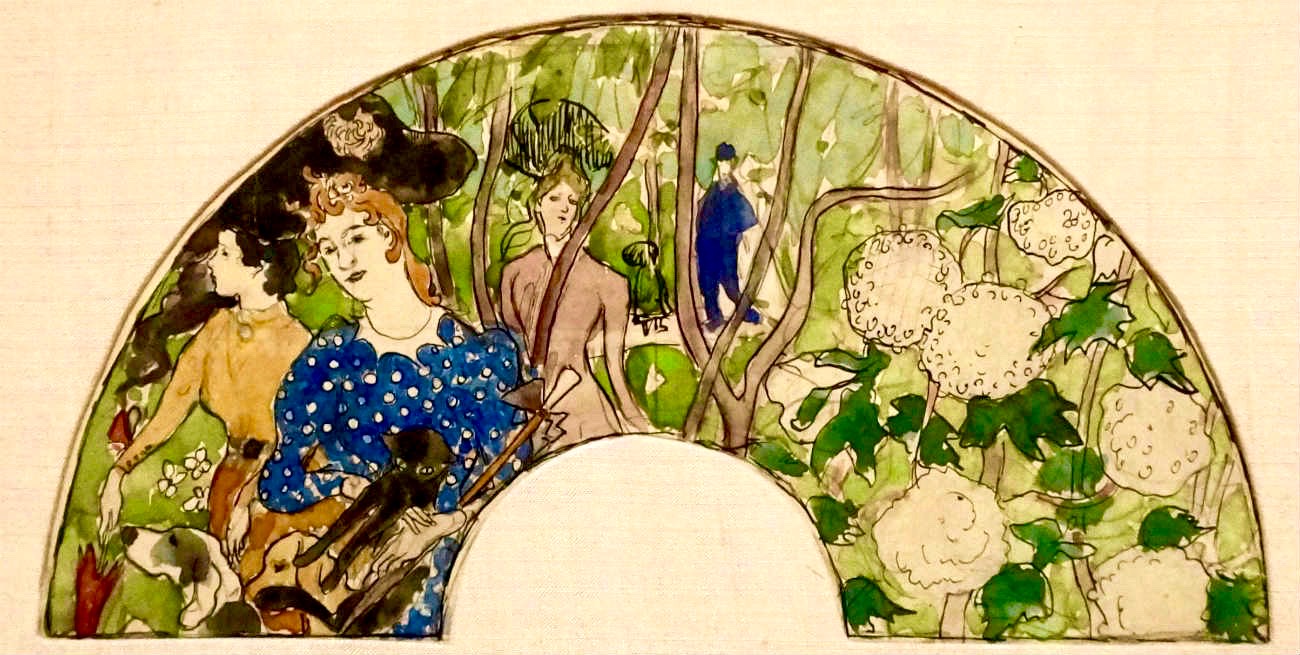
20.07 Писані красені. Про віяла, створені Полем Гогеном, Едгаром Дега та іншими митцями
[vc_row css_animation=”” row_type=”row” use_row_as_full_screen_section=”no” type=”full_width” angled_section=”no” text_align=”left” background_image_as_pattern=”without_pattern” css=”.vc_custom_1531238271335{padding-top: 20px !important;}” z_index=””][vc_column][vc_column_text]Чому деякі зі своїх робіт відомі митці написали у вигляді віяла? Відповідь на це запитання прийшла зі Сходу.[/vc_column_text][/vc_column][/vc_row][vc_row css_animation=”” row_type=”row” use_row_as_full_screen_section=”no” type=”full_width” angled_section=”no” text_align=”left” background_image_as_pattern=”without_pattern” css=”.vc_custom_1531337458295{padding-top: 30px !important;padding-bottom: 30px !important;}” z_index=””][vc_column width=”1/2″ css=”.vc_custom_1531949073180{padding-bottom: 30px !important;}”][vc_single_image image=”11220″ img_size=”full” add_caption=”yes” alignment=”center” style=”vc_box_shadow_3d” qode_css_animation=””][/vc_column][vc_column width=”1/2″][vc_single_image image=”11221″ img_size=”full” add_caption=”yes” alignment=”center” style=”vc_box_shadow_3d” qode_css_animation=””][/vc_column][/vc_row][vc_row css_animation=”” row_type=”row” use_row_as_full_screen_section=”no” type=”full_width” angled_section=”no” text_align=”left” background_image_as_pattern=”without_pattern” css=”.vc_custom_1591890588690{margin-top: 30px !important;margin-bottom: 30px !important;}” z_index=””][vc_column]
[/vc_column][/vc_row][vc_row css_animation=”” row_type=”row” use_row_as_full_screen_section=”no” type=”full_width” angled_section=”no” text_align=”left” background_image_as_pattern=”without_pattern”][vc_column][vc_column_text]Під час періоду Мейдзі (1868-1912) Японія бере активну участь у Всесвітніх виставках, де також представляє твори свого мистецтва.[/vc_column_text][/vc_column][/vc_row][vc_row css_animation=”” row_type=”row” use_row_as_full_screen_section=”no” type=”full_width” angled_section=”no” text_align=”left” background_image_as_pattern=”without_pattern” css=”.vc_custom_1531163133115{padding-top: 30px !important;padding-bottom: 30px !important;}” z_index=””][vc_column][vc_single_image image=”11222″ img_size=”full” add_caption=”yes” alignment=”center” style=”vc_box_shadow_3d” qode_css_animation=””][/vc_column][/vc_row][vc_row css_animation=”” row_type=”row” use_row_as_full_screen_section=”no” type=”full_width” angled_section=”no” text_align=”left” background_image_as_pattern=”without_pattern”][vc_column][vc_column_text]Світ вражений японської естетикою! 1872 року в серії своїх статей французький арт-критик Філіп Берті дає визначення захопленню всім японським, що охопило Європу та Америку, – японізм.[/vc_column_text][/vc_column][/vc_row][vc_row css_animation=”” row_type=”row” use_row_as_full_screen_section=”no” type=”full_width” angled_section=”no” text_align=”left” background_image_as_pattern=”without_pattern” css=”.vc_custom_1591890555911{margin-top: 30px !important;}” z_index=””][vc_column]1868 року на японський престол сходить імператор Муцухіто і проголошує відмову від двохсотлітньої політики ізоляції Країни сонця, що сходить.
[/vc_column][/vc_row][vc_row css_animation=”” row_type=”row” use_row_as_full_screen_section=”no” type=”full_width” angled_section=”no” text_align=”left” background_image_as_pattern=”without_pattern” css=”.vc_custom_1531337458295{padding-top: 30px !important;padding-bottom: 30px !important;}” z_index=””][vc_column width=”1/2″ css=”.vc_custom_1531949109190{padding-bottom: 30px !important;}”][vc_single_image image=”11224″ img_size=”full” add_caption=”yes” alignment=”center” style=”vc_box_shadow_3d” qode_css_animation=””][vc_empty_space height=”30px”][vc_single_image image=”11226″ img_size=”full” add_caption=”yes” alignment=”center” style=”vc_box_shadow_3d” qode_css_animation=””][/vc_column][vc_column width=”1/2″][vc_single_image image=”11223″ img_size=”full” add_caption=”yes” alignment=”center” style=”vc_box_shadow_3d” qode_css_animation=””][vc_empty_space height=”30px”][vc_single_image image=”11225″ img_size=”full” add_caption=”yes” alignment=”center” style=”vc_box_shadow_3d” qode_css_animation=””][/vc_column][/vc_row][vc_row css_animation=”” row_type=”row” use_row_as_full_screen_section=”no” type=”full_width” angled_section=”no” text_align=”left” background_image_as_pattern=”without_pattern”][vc_column][vc_column_text]Митці починають писати своїх моделей в кімоно, зображують їх на тлі або з японськими аксесуарами: ширмами, керамічними виробами, парасольками та віялами. Останні вважалися особливо вишуканими речами.[/vc_column_text][/vc_column][/vc_row][vc_row css_animation=”” row_type=”row” use_row_as_full_screen_section=”no” type=”full_width” angled_section=”no” text_align=”left” background_image_as_pattern=”without_pattern” css=”.vc_custom_1531337458295{padding-top: 30px !important;padding-bottom: 30px !important;}” z_index=””][vc_column][vc_single_image image=”11227″ img_size=”full” add_caption=”yes” alignment=”center” style=”vc_box_shadow_3d” qode_css_animation=””][/vc_column][/vc_row][vc_row css_animation=”” row_type=”row” use_row_as_full_screen_section=”no” type=”full_width” angled_section=”no” text_align=”left” background_image_as_pattern=”without_pattern” css=”.vc_custom_1532079326801{padding-bottom: 30px !important;}” z_index=””][vc_column][vc_single_image image=”11228″ img_size=”full” add_caption=”yes” alignment=”center” style=”vc_box_shadow_3d” qode_css_animation=””][/vc_column][/vc_row][vc_row css_animation=”” row_type=”row” use_row_as_full_screen_section=”no” type=”full_width” angled_section=”no” text_align=”left” background_image_as_pattern=”without_pattern”][vc_column][vc_column_text]Однак у європейців розписане віяло перетворюється на предмет декору: в розкритому вигляді його вішають на стіну як картину.[/vc_column_text][/vc_column][/vc_row][vc_row css_animation=”” row_type=”row” use_row_as_full_screen_section=”no” type=”full_width” angled_section=”no” text_align=”left” background_image_as_pattern=”without_pattern” z_index=”” css=”.vc_custom_1531937216573{padding-top: 30px !important;}”][vc_column][vc_separator type=”normal” color=”#dd8500″ transparency=”1″ thickness=”1″][/vc_column][/vc_row][vc_row css_animation=”” row_type=”row” use_row_as_full_screen_section=”no” type=”full_width” angled_section=”no” text_align=”left” background_image_as_pattern=”without_pattern”][vc_column][vc_column_text]Вам подобається стаття? Будь ласка, поширте її у соціальних мережах або станьте другом Музи на Фейсбуці та/чи в Інстаграмі. Amuse A Muse – некомерційний арт-проект, який було створено для популяризації знань з мистецтва та культури. Він зможе вирости лише за вашої допомоги.Образ екзотичної, витонченої, одягненої в яскраве вбрання гейші вражає художників.
Наталя Гузенко, авторка проекту[/vc_column_text][/vc_column][/vc_row][vc_row css_animation=”” row_type=”row” use_row_as_full_screen_section=”no” type=”full_width” angled_section=”no” text_align=”left” background_image_as_pattern=”without_pattern” z_index=””][vc_column][vc_separator type=”normal” color=”#dd8500″ transparency=”1″ thickness=”1″][/vc_column][/vc_row][vc_row css_animation=”” row_type=”row” use_row_as_full_screen_section=”no” type=”full_width” angled_section=”no” text_align=”left” background_image_as_pattern=”without_pattern” css=”.vc_custom_1532081492316{padding-top: 30px !important;padding-bottom: 30px !important;}” z_index=””][vc_column][vc_single_image image=”11232″ img_size=”full” add_caption=”yes” alignment=”center” style=”vc_box_shadow_3d” qode_css_animation=””][/vc_column][/vc_row][vc_row css_animation=”” row_type=”row” use_row_as_full_screen_section=”no” type=”full_width” angled_section=”no” text_align=”left” background_image_as_pattern=”without_pattern” css=”.vc_custom_1532081128314{padding-bottom: 30px !important;}” z_index=””][vc_column][vc_single_image image=”11231″ img_size=”full” add_caption=”yes” alignment=”center” style=”vc_box_shadow_3d” qode_css_animation=””][/vc_column][/vc_row][vc_row css_animation=”” row_type=”row” use_row_as_full_screen_section=”no” type=”full_width” angled_section=”no” text_align=”left” background_image_as_pattern=”without_pattern” css=”.vc_custom_1532081484202{padding-bottom: 30px !important;}” z_index=””][vc_column][vc_single_image image=”11230″ img_size=”full” add_caption=”yes” alignment=”center” style=”vc_box_shadow_3d” qode_css_animation=””][/vc_column][/vc_row][vc_row css_animation=”” row_type=”row” use_row_as_full_screen_section=”no” type=”full_width” angled_section=”no” text_align=”left” background_image_as_pattern=”without_pattern”][vc_column][vc_column_text]Куратори виставки «Імпресіонізм / Японізм» в Музеї імпресіонізму в Живерні стверджують, що такі делікатні та водночас сміливі для свого часу роботи вважалися прекрасним подарунком для дам: художники дарували їх своїм матерям, дружинам і коханкам.[/vc_column_text][/vc_column][/vc_row][vc_row css_animation=”” row_type=”row” use_row_as_full_screen_section=”no” type=”full_width” angled_section=”no” text_align=”left” background_image_as_pattern=”without_pattern” css=”.vc_custom_1531950371123{padding-top: 30px !important;padding-bottom: 30px !important;}” z_index=””][vc_column][vc_single_image image=”11229″ img_size=”full” add_caption=”yes” alignment=”center” style=”vc_box_shadow_3d” qode_css_animation=””][/vc_column][/vc_row][vc_row css_animation=”” row_type=”row” use_row_as_full_screen_section=”no” type=”full_width” angled_section=”no” text_align=”left” background_image_as_pattern=”without_pattern” z_index=””][vc_column][vc_separator type=”normal” color=”#dd8500″ transparency=”1″ thickness=”1″][/vc_column][/vc_row][vc_row css_animation=”” row_type=”row” use_row_as_full_screen_section=”no” type=”full_width” angled_section=”no” text_align=”left” background_image_as_pattern=”without_pattern”][vc_column][vc_column_text]Читайте також: Японець у Парижі. Дивовижний світ Фудзіти на виставці у Музеї Майоля[/vc_column_text][/vc_column][/vc_row][vc_row css_animation=”” row_type=”row” use_row_as_full_screen_section=”no” type=”full_width” angled_section=”no” text_align=”left” background_image_as_pattern=”without_pattern” z_index=”” css=”.vc_custom_1591890931398{margin-bottom: 30px !important;}”][vc_column][vc_separator type=”normal” color=”#dd8500″ transparency=”1″ thickness=”1″][/vc_column][/vc_row][vc_row css_animation=”” row_type=”row” use_row_as_full_screen_section=”no” type=”full_width” angled_section=”no” text_align=”left” background_image_as_pattern=”without_pattern”][vc_column][vc_column_text]Головна світлина: Жінки та квіти, олівець, акварель, коричнева туш на велені, П’єр Боннар, близько 1891, Van Gogh Museum, Амстердам[/vc_column_text][/vc_column][/vc_row]


